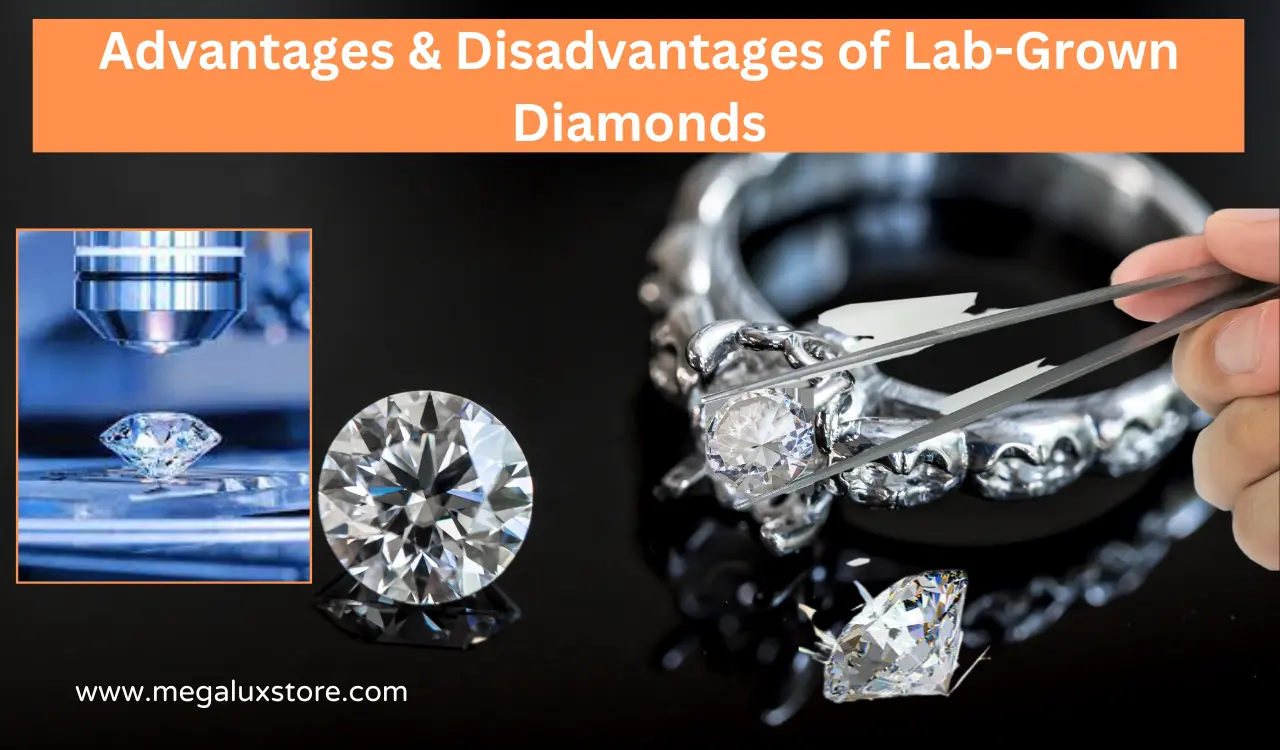Lab-grown diamonds, once a novel concept, have rapidly gained popularity in the jewelry industry. As technology advances, so does the production of diamonds in laboratories. While lab-grown diamonds have their merits, it’s crucial to delve into the disadvantages associated with them. This article explores various aspects, from environmental concerns to societal perceptions, shedding light on the disadvantages lab-grown diamonds over their natural counterparts.
What are Lab-Grown Diamonds?
Lab-grown diamonds, also known as synthetic or cultured diamonds, are created in a controlled environment, replicating the natural diamond-growing process. These diamonds have become increasingly prevalent in the jewelry market, presenting an alternative to traditionally mined diamonds.
Disadvantages of Lab-Grown Diamonds: Environmental Impact
- Energy-Intensive Production Process: One significant disadvantage of lab-grown diamonds lies in the energy-intensive nature of their production. The process involves high-pressure, high-temperature conditions or chemical vapor deposition, demanding substantial energy consumption. This raises concerns about the environmental footprint of lab-grown diamonds compared to their naturally occurring counterparts.
- Carbon Footprint Comparison: While lab-grown diamonds may seem environmentally friendly, a comparative analysis of their carbon footprint with mined diamonds reveals a nuanced picture. The energy sources used in the production contribute to greenhouse gas emissions, challenging the notion that lab-grown diamonds are a greener alternative.
Ethical Concerns For Lab-Grown Diamonds
- Issues Related to Transparency: Ethical considerations come to the forefront when evaluating lab-grown diamonds. Transparency in the sourcing and manufacturing processes becomes a concern, as consumers may be misled into believing they are purchasing a product with a more ethical origin.
- Potential for Misleading Marketing: The marketing of lab-grown diamonds can sometimes be misleading, creating an ethical dilemma. Claims of being “eco-friendly” or “conflict-free” may not always align with the actual practices of certain producers, leading to ethical challenges within the industry.
Disadvantages of Lab-Grown Diamonds: Lack of Rarity and Exclusivity
Abundance in the Market
One of the allurements of natural diamonds lies in their rarity. Lab-grown diamonds, being produced on demand, lack this intrinsic quality. The abundance of lab-grown diamonds in the market diminishes the sense of exclusivity traditionally associated with natural diamonds.
Disadvantages of Lab-Grown Diamonds: Impact on Perceived Value
The market saturation of lab-grown diamonds can impact their perceived value. With an oversupply, these diamonds may not hold the same allure and value retention as their naturally formed counterparts, affecting the investment aspect for consumers.
Price Devaluation in Lab Created Diamonds
- Lower Market Value: Lab-grown diamonds, while more affordable, suffer from lower market values compared to natural diamonds. This price devaluation can have economic repercussions for the diamond industry, impacting the livelihoods of those involved in traditional diamond mining.
- Economic Implications for the Industry: The shift towards lab-grown diamonds poses economic challenges for countries and communities heavily reliant on natural diamond mining. This transition can result in job losses and economic disparities within regions that depend on the diamond trade.
Disadvantages of Lab-Grown Diamonds: Perception and Social Stigma
- Cultural Attachment to Natural Diamonds
Society has long held a cultural attachment to natural diamonds. The symbolism and traditions associated with natural diamonds create a social stigma against lab-grown diamonds, often considered by some as “lesser” or lacking the historical significance of their naturally occurring counterparts.
- Perception of Lab-Grown Diamonds as “Lesser” : Despite technological advancements, the perception of lab-grown diamonds as inferior persists. Overcoming deeply ingrained cultural beliefs proves challenging, impacting the acceptance of lab-grown diamonds within certain consumer segments.
Disadvantages of Lab-Grown Diamonds: Limited Resale Value
Challenges in Reselling Lab Grown Diamonds
The resale market for lab-grown diamonds faces challenges. Consumers looking to sell or upgrade their lab-grown diamonds may encounter difficulties due to the oversupply and perceived lower resale value compared to natural diamonds.
Impact on Investment Potential
Investors considering diamonds as a long-term investment may find lab-grown diamonds less appealing due to their limited resale value. This factor influences the overall investment potential of lab-grown diamonds within the market.
Drawbacks of Lab Grown Diamonds: Technological Limitations
- Constraints in Achieving Certain Characteristics: While technology has advanced, lab-grown diamonds still face limitations in achieving certain characteristics found in natural diamonds. Some consumers may prioritize the unique qualities of natural diamonds, such as specific inclusions or growth patterns, which can be challenging to replicate synthetically.
- Continuous Advancements and Potential Improvements: Despite current limitations, ongoing technological advancements may address some of the constraints associated with lab-grown diamonds. As the industry evolves, improvements in replicating the characteristics of natural diamonds are expected.
Consumer Awareness While Growing Lab Diamonds
Lack of Awareness Regarding Differences
Many consumers lack awareness regarding the differences between lab-grown and natural diamonds. Educating consumers about the distinctions is crucial in fostering informed decision-making and dispelling misconceptions surrounding lab-grown diamonds.
Importance of Educating Consumers
Industry players have a responsibility to educate consumers about the nuances of lab-grown diamonds. Transparent communication regarding the benefits and limitations of lab-grown diamonds can empower consumers to make choices aligned with their values.
Drawbacks of Lab-Grown Diamonds: Market Saturation
Increasing Number of Lab-Grown Diamond Brands
The market for lab-grown diamonds is becoming increasingly saturated, with numerous brands entering the scene. While this provides consumers with choices, it also intensifies competition, making it challenging for brands to distinguish themselves.
Impact on Market Competitiveness
As the market becomes more saturated, brands must differentiate themselves to remain competitive. This dynamic can influence pricing strategies, marketing approaches, and overall market dynamics within the lab-grown diamond industry.
Challenges in Identifying Origins
Difficulty in Distinguishing Lab-Grown from Natural Diamonds
Identifying the origin of a diamond, whether natural or lab-grown, can be challenging for consumers. The lack of visible differences raises concerns about potential fraudulent practices within the industry.
Potential for Fraudulent Practices
The difficulty in distinguishing lab grown from natural diamonds creates opportunities for fraudulent practices. Unscrupulous actors may attempt to pass off lab-grown diamonds as natural, impacting consumer trust and the overall integrity of the diamond market.
Disadvantages of Lab Grown Diamonds: Industry Impact
- Disruption in the Traditional Diamond Market: The rise of lab-grown diamonds has disrupted the traditional diamond market. Natural diamond producers face challenges in adapting to this shift, leading to changes in industry dynamics and competitive landscapes.
- Response from the Natural Diamond Industry:
- In response to the growth of lab-grown diamonds, the natural diamond industry has sought to emphasize the unique qualities and heritage associated with naturally occurring diamonds. This response aims to maintain the appeal of natural diamonds in the face of increasing competition.
Long-Term Durability Concerns
Questions about the Longevity of Lab-Grown Diamonds
As lab-grown diamonds are a relatively recent addition to the market, questions arise about their long-term durability. While advancements continue, the long-term performance and resilience of lab-grown diamonds compared to natural diamonds remain a subject of scrutiny.
Comparative Analysis with Natural Diamonds
Consumers considering lab-grown diamonds may weigh the long-term durability against the time-tested resilience of natural diamonds. This comparative analysis influences purchasing decisions and perceptions of value.
Disadvantages of Lab Grown Diamonds: Regulatory Considerations
- Lack of Standardized Regulations
The lab-grown diamond industry currently lacks standardized regulations. The absence of universally accepted guidelines raises concerns about quality control, ethical practices, and consumer protection within the industry.
- Need for Industry-Wide Guidelines
The establishment of industry-wide guidelines and standards is essential for ensuring the integrity and trustworthiness of the lab-grown diamond market. This includes clear parameters for labeling, quality assurance, and ethical sourcing.
Conclusion
In conclusion, while lab grown diamonds offer an alternative in the jewelry market, they come with their set of disadvantages. From environmental concerns and ethical considerations to market saturation and perception challenges, the decision to choose lab-grown over natural diamonds requires careful consideration. As the industry continues to evolve, striking a balance between innovation and maintaining the intrinsic qualities of natural diamonds is crucial for a sustainable and ethically conscious 1.1 jewelry market.
Frequently Asked Questions
Are lab created diamonds not as good?
Lab-created diamonds are just as good as natural diamonds in terms of quality, brilliance, and durability. They offer a more ethical and sustainable alternative without compromising on beauty or value.
Is it safe to buy lab-grown diamonds?
Yes, buying lab-grown diamonds is safe. Lab-created diamonds undergo rigorous testing and are chemically identical to natural diamonds. They offer a conflict-free and sustainable option without compromising on safety or quality.
Are lab-grown diamonds losing value?
Lab-grown diamonds are not losing value. In fact, their popularity is rising due to ethical sourcing and environmental sustainability, making them a valuable and cost-effective alternative to natural diamonds.
Do lab diamonds fade?
No, lab diamonds do not fade. They maintain their brilliance and quality over time, offering a durable and long-lasting alternative to natural diamonds.
Why are lab diamonds a poor investment?
Lab diamonds are not a poor investment. They offer a more affordable and ethical option without compromising on quality. Their value remains stable, making them a smart choice for conscientious buyers.
Which country has No 1 diamond in the world?
Russia has the world’s No. 1 diamond production, making it a leading diamond-producing country.





